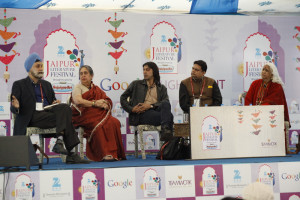
Jaipur Literature Festival
An interview of Esther David, Jewish-Indian sculptor-artist and Sahitya Akademi award winning author of The Book of Rachel, talks about life as a Jew in India to Sonal Srivastava at the Jaipur Literature Festival.
What is it like to be Jew in a majority Hindu India?
First thing, it’s a matter of great pride and respect that Jews have never been persecuted in India. Wherever we go, people accept us.
I belong to the Bene Israel Jewish community that came to India 2,000 years ago following a shipwreck. We landed on the Konkan coast, so there is a lot of Maharashtrian influence on our community. For example, I come from Danda village, so my family name is Dandekar. But now that the family has become anglicised, we don’t use it anymore. However, if someone from the community asks which village I’m from, I say, ‘Danda; I’m a Dandekar.’ But most people have retained their Indian surnames — so they have a biblical name as well as an Indian surname.We have adopted the Indian way of life. People in my community don’t wear a bindi, but I do. We practise our religion behind ‘closed doors’ — a secret Jewish life; mostly nobody is allowed to enter our synagogue, and that’s how we have remained Jewish. There are a lot of do’s and don’ts in our community.
What are these do’s and don’ts?
n For instance, women are not supposed to stay out late at night. If they go shopping, they have to go in groups, preferably with other Jewish women. These rules specifically pertain to women and everybody adheres to them. Then, there are dietary laws about food and laws about dresses that we should wear, and about our behaviour. Only recently, since the last two or three years, I see Jews celebrating Holi. Earlier, we were not allowed to play Holi or participate in Navaratri celebrations. Our religious education is given at home; there is a code of conduct at home and at the synagogue. A large part of our community has migrated to Israel. There are only 4,000 Jews in India now and we stay connected. If you stay together, you preserve your religion.
Israel is in conflict with the Arab world. So, how does that affect your life in India?
There has never been a problem. Earlier, most of our synagogues and our homes were in Muslim communities, but now we have moved out to more cosmopolitan cities. However, some of our synagogues still remain in Muslim communities. In Ahmedabad, there is a synagogue opposite a Parsi fire temple; behind that is a church, and on it’s right, there is a mosque. Nearby, there is a temple. In the evening, prayers in all these places of worship begin; so you can hear temple bells and calls of muezzins all over — it is interesting.
You said Jews have started playing Holi. What else is changing in the Jewish community in India?
We have started participating in Navaratri, a big festival in Gujarat, when everybody is wearing beautiful clothes and is out dancing the whole night. You cannot deny it to the younger generation. So the whole family participates in the festival. Holi is still a bit of a problem because of the free mingling of the sexes — though, more or less, they try to keep the girls from playing Holi. It is done to keep the Jewish family structure intact, so that they dont marry outside the community as the community is getting smaller.
You said you follow religion behind ‘closed doors.’ What kind of spiritual education is imparted to the young?
We came to India because of a shipwreck, so all the scriptures were lost to the sea. We had an oral tradition, one was Shabath — Friday night prayers. Second thing they knew was burial — if someone dies, he has to be buried and not cremated. Third was prayers to Prophet Elijah. The other things we followed were circumcising the male child and the law that says the Lord, the God is one and that there is one, faceless God — that’s the hard part of being a Jew. All that I’m telling you is part of my novels — the discovery, the search, an abstract notion. I didn’t know what it was to be Jewish because I didn’t come from a religious family. I went through various problems that Jewish women face in India.
Can you cite a few instances of the problems you faced while growing up?
Two things happen when one is young: one is a great desire to dress like everyone else and wear unisex clothes that are worn globally. Second is getting attracted to someone outside the community. For this reason, some families prefer to take their daughters to Israel. Third thing is dietary laws — almost everybody follows them, but sometimes a young teenaged boy may not want to follow them. These conflicts are just like conflicts in other families in India. Jews place a lot of emphasis on education. The more we get exposure, the more we have desires and then coping with rules becomes difficult.
You said the hardest part of being a Jew is the abstract notion of one faceless God. What is your perception of the Hindu pantheon of gods?
I went to art school. Normally, Jews keep their children away from art schools because art can be polluting. So when I went to art school, there was immense conflict; I was continuously exposed to many gods, temples, forms and faces. I used to wonder what should be the face of God and question why Jews don’t have that. Even if you go to Navaratri pandals, you cannot avoid the face of Durga and her big eyes. Between art and literature, I tried to create an imagery of this conflict.
Courtesy : SpeakingTree.in
